HONEY
 oney is made from flower nectar collected by worker bees in spring, summer, and early autumn. Some worker bees also collect the sugary secretions of aphids that feed on tree sap, a substance known as honeydew. The gathered nectar is stored in wax cells, thousands of which form the honeycomb. It is concentrated as the bees fan the comb with their wings to drive off excess moisture. In a natural honeybee colony, honey serves as food for the bees through the winter, when plants are dormant. In an apiculture hive, most of the honeycomb is removed to harvest the honey and beeswax, and the beekeeper provides sugar or corn syrup solution to sustain the bees.
oney is made from flower nectar collected by worker bees in spring, summer, and early autumn. Some worker bees also collect the sugary secretions of aphids that feed on tree sap, a substance known as honeydew. The gathered nectar is stored in wax cells, thousands of which form the honeycomb. It is concentrated as the bees fan the comb with their wings to drive off excess moisture. In a natural honeybee colony, honey serves as food for the bees through the winter, when plants are dormant. In an apiculture hive, most of the honeycomb is removed to harvest the honey and beeswax, and the beekeeper provides sugar or corn syrup solution to sustain the bees.
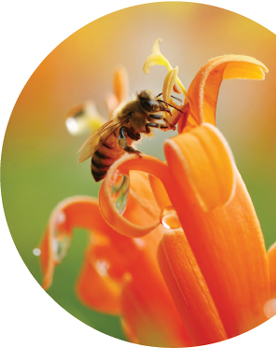
Beekeepers earn most of their income by renting bee colonies to farmers and orchardists. The hives are transported to places where important crops are blooming, and the bees pollinate the crops as they gather nectar and pollen. Pollinating California’s almond trees alone requires about one million bee colonies. The tasty result of all this pollination effort is honey. Global honey production is worth over $1.25 billion annually. While that’s a significant amount, it’s only a fraction of the value of the bees’ pollination efforts, which are estimated to be worth $16 billion annually to agriculture in the United States alone.
For millennia, honey has been appreciated for its delicious sweet flavor and digestibility. In both ancient and modern times, Buddhist, Christian, Hindu, Moslem, and Native American cultures have revered the honeybee. China has a continuous tradition of apiculture that stretches back over three thousand years. In the 1600s, workers in Shenyang collected 2,500 to 3,000 kilograms of honey each year just to supply the Manchu Imperial Palace. Globally, it wasn’t until after the Industrial Revolution that sugar became more widely available than honey. In preindustrial times, Europeans ate about as much honey as they do sugar today—15 to 30 kilograms per year.
Honey is 15 to 21 percent water by weight, with almost all of the remainder consisting of carbohydrate. About 85 percent of the solids in honey are the simple sugars glucose and fructose. Also included are minor amounts of sucrose, maltose, and other sugars, the exact composition varying with the honey. In addition, honey contains larger, complex sugar molecules called oligosaccharides. Although we humans can’t easily digest oligosaccharides, the beneficial bacteria in our guts thrive on them, so they are valuable prebiotics. (Prebiotics are non-digestible components of food that promote the growth of beneficial microorganisms in the intestines.) As I’ll discuss later, moderate amounts of honey can be beneficial for diabetes, and its oligosaccharide content is one of the reasons for this.

The sugar molecules in honey are strongly attracted to its water and bond to it. This is one reason why honey is a viscous syrup, not a crystalline solid like table sugar (pure sucrose). When honey is dried, it rapidly reabsorbs water from the atmosphere and returns to its liquid state. However, honey does crystallize sometimes. This can occur spontaneously in a jar that has been on the shelf for a while, or it may be purposely crystallized to make spreadable honey products. However, even when crystallized, honey is still sticky and contains lots of water.
Honey: A Botanical Product
Less than 4 percent of honey consists of phytochemicals from the plants that supplied the nectar, but this minor fraction is responsible for the endless variations in honey. Unprocessed or lightly processed honey retains the flavor and aroma of the nectar source plants, making it truly special. In fact, high-quality unprocessed honey is like fine wine, with the source plants, growing location, season, climate, weather, processing, and just plain luck influencing the color, aroma, and flavor. Commercial beehives placed in orange groves produce fragrant orange-scented honey, while those in white clover fields produce light, mild, all-purpose honey. Nectar from buckwheat flowers yields strong, dark, musky honey that’s an excellent substitute for molasses in baking or barbecue sauce. However, buckwheat honey is like buckwheat pancakes—definitely an acquired taste for many people.

The various phytochemicals in honey not only influence the honey’s flavor and aroma but also have antioxidant and healing properties and provide nutritional benefits. Apicultural scientists are interested in identifying the phytochemical composition of honey for several reasons. Most importantly, the trace phytochemicals in honey provide a fingerprint that can be used to identify the source plants visited by the bees. Phytochemicals in honey are extracted and then compared to phytochemical extracts and pollen from likely source plants near the hives where the honey originated.
In any given foraging area, many potential source plants exist and may be represented in the honey. But in practice, bees repeatedly visit favorite plants, presumably because these plants provide more abundant and nutritious nectar and pollen. These plants may also be more accessible or attractive to bees. Less competition from other insects is another factor. Identifying preferred source plants yields information on which plants keep bees healthy and productive and helps beekeepers know where to place their hives.
There are also some source plants that beekeepers don’t want their bees to visit. For example, wild tropical honeys occasionally poison animals because the flowers of the source plants are poisonous to mammals but not to insects. Honey with a high concentration of nectar from certain plants in the heath family, including mountain laurel, sheep laurel, and some species of rhododendron, can contain poisonous compounds called grayanotoxins, which can cause nausea, vomiting, excessive perspiration, and dizziness. If the honey is eaten only in moderation, these symptoms will resolve with no permanent effects once the honey is no longer consumed. However, the poisoning can be life-threatening if these honeys are eaten in large quantities. That said, most cases of grayanotoxin poisoning have occurred when children, livestock, or pets consumed the source plants, not honey derived from them.
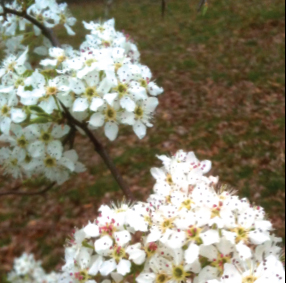
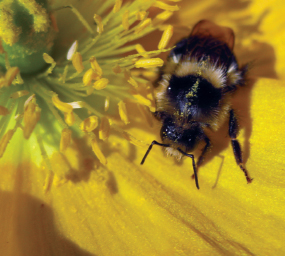
Phytochemical fingerprinting is also useful for legal reasons. For honey to be labeled as unifloral (from a single floral source), 51 percent of its nectar or 45 percent of its traces of pollen must be from the designated source plant. Although these percentages seem low (can you imagine orange juice that’s required to be only 51 percent from oranges?), there’s no practical way to further control the content. So even when hives are located in the middle of a vast clover field, for example, laboratory identification of characteristic clover phytochemicals or pollen is required in order for the honey to be labeled and sold as “clover honey.”
Over time, characteristic phytochemical patterns in popular honey varieties began to emerge, and it was not lost on researchers that many of the phytochemicals in those fingerprints are active ingredients in herbal preparations. For example, Australian eucalyptus honeys are identified by small amounts of eucalyptus essential oil components (including cineole and menthol) and the flavonoids myricetin, kaempferol, luteolin, and tricetin. Orange-blossom honey has a small amount of orange essential oil (including citral and limonene) and the flavonoid hesperetin. Malaysian honey, with nectar from Melaleuca cajuputi (gelam tree), a cousin of the tea tree (Melaleuca alternifolia), is a source of cajeput, which is similar to tea tree oil. Likewise, honeys from heather, rosemary, sage, and thyme have small amounts of the essential oils characteristic of those plants, resulting in distinctive aromas and flavors in the honey and also contributing medicinal benefits.
Antioxidants in Honey
Floral honeys can contain relatively high levels of phytochemical antioxidants from the source plants. The highest reported antioxidant content in a unifloral US commercial honey was in Illinois buckwheat honey, and the lowest was in California sage honey, with the buckwheat honey being twenty times richer in antioxidants than the sage honey. Other US honeys with high antioxidant content include Hawaiian Christmas berry, sunflower, and water tupelo. Among Canadian varieties, blueberry, buckwheat, and tupelo honeys are highest in antioxidant capacity. European winners include fir, hawthorn, mixed forest, pine, raspberry, and thyme.
All studies concur that the darker the honey, the higher the antioxidant content. Although lighter, transparent honeys, such as clover, lime, mesquite, and orange are more common, they are less remarkable in their antioxidant content. In contrast, buckwheat, eucalyptus, fir, pine, and water tupelo are dark brown or greenish brown and translucent. When humans ingest dark honeys, their bloodstream antioxidant capacity reliably increases.
The major antioxidant phytochemicals in honey are identical to those in fruits, vegetables, herbal products, bee pollen, and propolis. Most important are flavonoids and other phenolic compounds. Darker honeys are dark precisely because they have higher concentrations of phenolics, which impart brown, green, or dark yellow colors. This higher phenolic content accounts for most of the increased antioxidant activity. Ascorbic acid (vitamin C) and other organic acids (caffeic, cinnamic, gluconic, hydroxybenzoic, and malic) are other important antioxidants in honey.
Although honeybees are native to Europe, they easily adapt to new types of vegetation, creating variations not just in the honey produced but also in the pollen collected, propolis, and royal jelly. A key determinant of the phenolic and flavonoid content of honeys is whether they are from temperate or tropical regions. Just as fruits from temperate and tropical locales differ in terms of flavor, aroma, and texture, so do honeys. Major antioxidant flavonoids found in all temperate-climate honeys studied are chrysin, galangin, pinobanksin, and pinocembrin.

Honeys from the southern hemisphere have their own distinctive compositions. Some that are exceptionally rich in antioxidants include those sourced from Malaysian gelam trees, New Zealand manuka trees, and, in Australia, various trees in the genus Eucalyptus (red river gum, mallee, and yellow box).
Honey as Part of a Nutritious Diet
Honey, especially raw honey, is nutritionally superior to white, brown, and “raw” sugars and fructose. Its sugars are easily digested, and the vitamins, minerals, and enzymes present in raw honey aid digestion and metabolism. Prebiotic oligosaccharides provide another nutritional boost, allowing honey to act as a soluble fiber.
Honey has a long shelf life compared to a sugar solution of similar concentration and viscosity. One reason is that its natural antioxidants and essential oils act as preservatives. In fact, honey can serve as a safe, natural preservative for other foods, with buckwheat, soybean, and tupelo honeys being among the best choices for this purpose.
Dipping fresh-cut fruits such as apples and pears into honey slows browning due to oxidation. Likewise, stirring a bit of honey and 1?8 to 1?4 teaspoon of vitamin C powder into a fruit salad will keep it fresh longer while also improving its nutritional value.
Most people use honey in tea or coffee or on toast, waffles, or pancakes. You can also use it as a sweetener when making barbecue sauces, salad dressings, vegetable dips, lemonade, and iced tea. It’s best to use it in unheated preparations or to add it after heating, as the natural vitamin C and most of the other antioxidant organic acids are destroyed by heat.
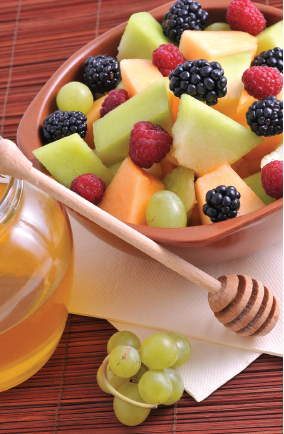

Honey, Diabetes, and Metabolic Syndrome
Although honey is superior to sugar, in comparison to fruits and vegetables it is lower in phytochemicals and much higher in sugar. Therefore, it’s a good substitute for refined sugar, but it shouldn’t replace fruits, vegetables, or herbal preparations. Remember, about 85 percent of honey consists of glucose and fructose, so it’s a highly concentrated source of simple sugars. Excessive consumption is particularly contraindicated for anyone with diabetes, abnormal glucose tolerance, hypertension, or obesity. However, when used in modest amounts as a sweetener, honey can benefit diabetics and can even aid in weight loss.
Because honey contains a great deal of fructose, you may wonder how it can possibly be healthful, given the growing concern about high-fructose corn syrup (HFCS). To adequately address this complex topic, I must first provide a bit of information about HFCS and its downsides. In the United States, consumption of this highly processed sweetener increased by more than 1,000 percent between 1970 and 1990, far exceeding changes in intake of any other food or food group. HFCS now accounts for more than 40 percent of caloric sweeteners added to foods and beverages.
It hasn’t escaped notice that increased use of HFCS in the United States has mirrored rapid increases in obesity and type 2 diabetes. However, only when people drink a lot of sodas and sweetened juices and teas—consuming on the order of 100 grams of fructose per day—is there a strong link between HFCS and obesity and metabolic syndrome. (Metabolic syndrome, a condition that greatly increases the risk of cancer, cardiovascular disease, chronic inflammation, and type 2 diabetes, is a complex disorder that involves many factors, including genetics, diet, and environmental conditions. However, the primary cause is obesity.) Additionally, high consumption of soft drinks is correlated with high intakes of fast foods, chips, candy, and baked goods, which are definitely linked to obesity and metabolic syndrome.
Modest amounts of fructose contained in fruits, vegetables, and honey have always been part of the human diet and are beneficial. In every human and animal study to date, consuming honey has proven to be beneficial or neutral with respect to controlling blood sugar, never harmful. However, the current consumption of large amounts of fructose in refined foods is unprecedented. Human metabolism isn’t equipped to deal with this excess, particularly in the form of HFCS, which didn’t even exist before the mid-1900s.
In contrast to HFCS, in moderate amounts honey confers the following potential benefits that may not only help to improve overall health but may also mitigate symptoms of diabetes and metabolic syndrome:
• Honey’s natural blend of sugars are released into the bloodstream more slowly than sucrose, so honey doesn’t spike blood sugar levels as much as sugar and HFCS.
• The prebiotic oligosaccharides in honey are helpful in promoting good digestion and regulating blood sugar levels.
• Honey provides a stronger feeling of satiety than refined sugars.
• Honey doesn’t raise levels of triglycerides or LDL (bad cholesterol) or increase blood pressure.
• Honey, particularly darker varieties, contains numerous powerful antioxidants, including some that are nonexistent or rare in fruits and vegetables.
I believe that metabolic syndrome is not a disease; rather, it is the predictable response of human physiology, evolved over eons, to chronic “high-calorie malnutrition.” By that, I mean heavy consumption of refined and processed foods that don’t contain enough vitamins, trace elements, and fiber to metabolize the calories in the food. Honey has the advantage of being a natural food that human physiology is adapted to, and consequently it isn’t implicated in blood sugar problems and can instead be part of the solution.
Honey: A Natural Antibiotic and Antiseptic
In ancient times, honey was revered for its healing properties. Greek, Roman, Islamic, Chinese, Egyptian, sub-Saharan, and Native American cultures all used honey medicinally. It has been utilized to treat colds, diarrhea, flus, indigestion, skin and stomach ulcers, sore throats, and wounds. Research has strongly confirmed the healing properties of honey—more definitively than for any other natural product. Raw unprocessed honey is a broad-spectrum antibiotic, inhibiting the growth of numerous pathogenic bacteria. Even when highly diluted, honey has antimicrobial properties. Some honeys are effective against skin fungi as well.
Honey may prove to be especially beneficial in fighting antibiotic-resistant infections in hospitals and clinics, which have become so common that some surgical patients must be quarantined. Most of these infections are from staphylococcus bacteria, which are often naturally present on the skin. If you have a large wound or surgical incision and skin bacteria in the area can’t be controlled, you’re at tremendous risk for a disfiguring scar or even a life-threatening infection.
Because honey is known to kill bacteria cultured from septic wounds, it has been investigated for its ability to treat infections resistant to standard antibiotics, particularly by noted honey researcher Peter Molan at the University of Waikato, New Zealand. In over one hundred reports describing thousands of different patients, his team found that honey cleared up infections that were unresponsive to conventional antiseptics and antibiotics. It quickly healed wounds that were infected with dangerous strains of staphylococcus resistant to penicillin or multiple antibiotics. Molan and his colleagues cultured Staphylococcus aureus and various species of pseudomonas bacteria collected directly from infected patient wounds and, based on their studies, concluded that honey dressings could prevent the growth of these bacteria in wounds, even when diluted as much as fourteenfold by body fluids. However, if dressings are changed several times per day, the honey should never become this diluted. Manuka honey was the most effective of fifty-eight honeys tested against Staphylococcus aureus and maintained its ability to kill this pathogen even when diluted by a factor of fifty-six. It was also far more effective against pseudomonas than mixed-pasture honey was.
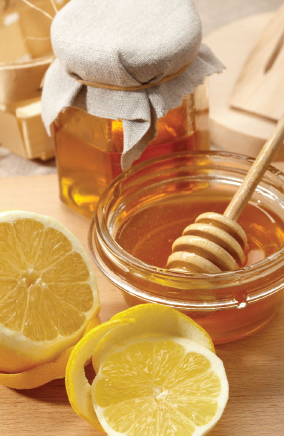

Brazilian researchers have found tropical South American honeys to be similarly effective against Staphylococcus aureus, and Canadian researchers found blueberry and buckwheat honeys effective against E. coli. Malaysian tualang honey is especially effective against several types of bacteria that infect people who have serious burns and compromised immune systems.
Overall, antimicrobial activity is generally higher in stronger-tasting honeys from aromatic plants such as conifers, culinary herbs, eucalyptus, mint, and species in the genus Melaleuca. And as with antioxidant activity, antimicrobial activity also tends to be stronger in darker honeys.
New Zealand’s manuka honey, mentioned above in conjunction with Peter Molan’s research, is considered superior for medicinal use. Overall, manuka honey, sold under the brand name Medihoney, is effective against more types of bacteria at lower doses than any other honey known. This stands to reason, given that essential oil extracted from the manuka tree has long been used topically to prevent or cure fungal and bacterial infections and soothe diaper rash, dermatitis, and psoriasis. It has also been used in mouthwashes and rinses to kill oral bacteria.
The effective antimicrobial properties of manuka essential oil are derived in part from the terpenoids cineol, cymene, myrcene, and pinene, which are also present in the dark, fragrant honey. In addition, manuka honey has a high total concentration of phenolics and other flavonoids and a notably wide variety of phytochemicals in general, some of which have not been found in other honeys. Some of them, such as caffeic acid and methylglyoxal, are powerful antimicrobial agents. Finally, manuka honey has a relatively high protein content, which causes the honey to set up like a gel, making wound dressing easier and less messy.
Honey for Wounds and Skin Infections
Ancient warriors carried raw honey with them to treat battlefield wounds, as it was known that cuts, abrasions, or burns covered with a layer of honey would heal more rapidly and with less chance of infection. Raw honey mixed with propolis was also utilized in this way.
Honey has been used successfully to heal many types of lingering or chronic skin infections or wounds, including abscesses, bedsores, boils, burns, cuts, gangrene, skin grafts, surgical incisions, and various sorts of skin ulcers. It’s equally effective for animals, healing wounds resulting from a variety of causes, including veterinary surgery. Here is a summary of some of the properties that give honey its amazing wound-healing power:
• Honey reduces infection, inflammation, weeping, and foul odors.
• Honey heals wounds faster and more cleanly than other treatments.
• Honey actively promotes the growth of healthy new skin.
• Honey doesn’t cause dermatitis or allergic reactions.
• Honey dressings soothe pain and itching.
• Honey dressings soften scabs and gently remove crusts and dead tissue.
Honey has been used to treat tough medical cases that weren’t responding to conventional treatment, such as diabetic ulcers that had festered for one to three years. What a welcome relief that must be for patients suffering from such challenging health issues. Honey is also a gentler, far more tolerable agent for removing dead tissue from sore, infected wounds, whereas surgical removal (debridement) is exceedingly painful. Patients whose wounds are literally untouchable are able to have their wounds properly cleaned when honey dressings are used.
Studies have shown that honey-impregnated gauze is better than or at least the equivalent of its conventional counterparts in preventing infection in burns and varicose ulcers. It also has proved to promote faster and more effective healing than conventional treatments, including hydrofiber silver gels, hydrogels, gauze infused with silver sulfadiazine (an antiseptic), polyurethane film, and amniotic membrane. Plus, amniotic membrane is a very expensive and specialized dressing, especially compared to honey and gauze.
Wound infections following cesarean section or hysterectomy healed faster and more cleanly with honey than the standard alcohol-and-iodine treatment. Honey treatments reduced the average postoperative scar width by nearly two-thirds and the duration of hospitalization by half.
Mutya Subrahmanyam, MD, a specialist in burn treatment, has reported that skin grafts can be stored in honey at room temperature. After six weeks of storage, there was a 100 percent success rate for graft uptake, and after twelve weeks the success rate was 80 percent. In addition, treating wounds with honey prior to skin grafting operations resulted in better graft uptake. Finally, the large stripping-type wounds at skin graft donor sites healed faster and with less pain when dressed with honey-impregnated gauzes than with paraffin gauzes or saline-soaked gauzes. When compared to hydrocolloid, an expensive specialized wound dressing, healing was essentially the same but much less costly. In all of these cases honey saved both the hospital and patients considerable time and expense. Given that honey is so effective, safe, affordable, and practical for skin graft surgery, you can see what a great option it is for your minor cuts and abrasions!
Honey for Dermatitis, Hemorrhoids, and Fungal Infections of the Skin
Saudi physician Noori Al-Waili, an expert on medicinal honey, has successfully treated many patients with skin fungal infections, diaper rash, hemorrhoids, and anal fissures with a salve made of equal parts honey, olive oil, and beeswax. This salve is an ancient treatment mentioned in the Bible and Koran. He also used the salve for allergic dermatitis and psoriasis, and within two weeks, more than half of the patients who received this treatment had skin that was softer and less red and itchy. In addition, all of these patients reduced their use of steroid drugs by 75 percent without experiencing flare-ups. Once again, honey treatments cost less and also had no side effects compared to standard drug therapy.
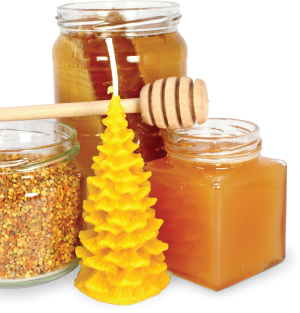
Honey for Gastric and Oral Healing
Honey was a remedy for indigestion, ulcers, diarrhea, and various stomach pains throughout the ancient world, thanks to its antimicrobial and healing properties. Case reports from New Zealand physicians especially recommend manuka honey for gastric healing and protection. A combination of bee products can also be effective. For example, taking a mixture of honey, royal jelly, and propolis on an empty stomach fifteen minutes before bedtime may heal stomach ulcers and prevent heartburn (see page 62 for specific information on using this remedy).
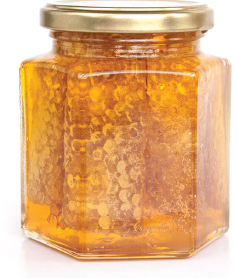
Honey is effective against pediatric infectious gastroenteritis, which causes diarrhea, vomiting, and fever and is a major problem worldwide. In one study, 196 infants and children with gastroenteritis were assigned to receive either 5 percent glucose (the standard treatment) or 5 percent honey in a rehydration solution. All who received honey recovered as well as or better than those who received glucose. A subgroup diagnosed with bacterial infections recovered in an average time of fifty-eight hours when given honey, compared to ninety-three hours with glucose.
Acids produced by oral bacteria are responsible for eroding dental enamel and eventually causing cavities. Perhaps surprisingly, given honey’s sugar content, it may help fight tooth decay. In a study that compared a chewable “honey leather” made with manuka honey to sugarless gum for the control group, thirty subjects chewed or sucked either the honey product or gum for ten minutes, three times a day, after each meal. The honey product was found to be twice as effective as sugarless gum in reducing plaque levels and gum bleeding. The antibacterial effect of manuka honey was so strong that it overrode the potential detrimental effect of the sugars in the honey.
Persistent mouth sores (mucositis) are a side effect of radiation treatment for cancer, and conventional medicine offers no effective remedy for this condition. However, patients with mucositis who were given honey daily after radiation had fewer sores, less pain, and fewer oral infections compared to those who received standard care, which in this case essentially means doing nothing. Honey made it possible for one-third of patients to eat properly during radiation therapy. Mucositis may respond even better to honey mixed with royal jelly and propolis.
How Honey Heals Wounds
All raw honey contains propolis and bee pollen, which have healing properties outlined in earlier chapters. In addition to these, there are five major properties of honey that make it such a powerful agent for healing wounds.
HYDROPHILIC SUGARS. All honey is 15 to 21 percent water. Most of the remainder is glucose and fructose. These sugars are strongly attracted to the water and bond to it to form a syrup. This property is valuable because a layer of honey over a wound will absorb fluids from the wound, desiccating bacteria and fungi and inhibiting their growth. This is the primary reason why honey rapidly clears wound infections.
GLUCOSE OXIDASE. Raw honey contains the enzyme glucose oxidase, which breaks down glucose, producing hydrogen peroxide in the process. This only occurs when the honey comes into contact with water or water-rich fluids. When raw honey comes into contact with body fluids leaking from an open wound, the enzyme is activated. Hydrogen peroxide is a powerful antiseptic and anti-inflammatory. While fine for initial sterilization, it irritates tissues and prevents healing when continually used on wounds. However, the glucose oxidase in honey produces small but steady amounts of hydrogen peroxide—just enough to sterilize wounds and stimulate tissue repair but not so much that it interferes with healing. Once the wound heals and dries up, the glucose oxidase is no longer activated, so no unneeded peroxide is produced. Keep in mind that the naturally occurring enzymes in honey are destroyed by pasteurizing and heating, improper storage, and bright light, so most commercial honeys lack the ability to make hydrogen peroxide.
COMPLEX COMPOSITION. Floral honey contains additional healing and antiseptic compounds, with the composition varying depending on the plants from which the honey originated. Stronger, darker honeys and those derived from aromatic plants have greater antioxidant and antimicrobial activity. For medicinal use, honeys derived from buckwheat, eucalyptus, manuka, sage, thyme, or mixed desert plants are good, readily available choices. In India, neem and lotus honeys are revered for their healing properties, as are gelam and tualang honeys in Malaysia.
ANTI-INFLAMMATORY PROPERTIES. Honey is anti-inflammatory. Wounds that aren’t healing well are almost always afflicted with chronic inflammation. This often manifests as a ring of angry red tissue doming up around a wound. Inflamed wounds cause pain, burning, and itching.
ACIDITY. Honey is naturally acidic, with a pH in the range of 3.2 to 4.5, which inhibits the growth of many microorganisms. This is a major reason why honey keeps so well on the shelf. Note that when honey is diluted, its acidity decreases. When honey is used on an open wound, it’s constantly in contact with body fluids, which dilute the honey, rendering it less acidic. Therefore, the acidic antimicrobial action of honey is not sustained and can only partially account for honey’s healing effects.
Purchasing and Storing Honey
Despite its medicinal properties, honey is purchased primarily for its flavor. Raw honey that’s unprocessed or only lightly processed retains the flavors and aromas of the nectar source plants, but its characteristics can vary widely. Highly processed honey has a more predictable flavor, but it’s also bland and unexceptional. Medicinally and nutritionally, raw honey is the best choice. It is extracted from the comb with a minimum of processing and isn’t overheated or sterilized. It contains active enzymes, vitamins, and volatile chemical constituents that are destroyed or removed by heating and processing. If you have children, start giving them raw honey early (but not until they are ten to twelve months old) so their palates become educated to flavors beyond just sweet.
To find flavorful, high-quality honeys, visit a farmers’ market or natural food store in an area known for apiculture. Specialty markets, particularly those with goods from Russia, the Baltic states, eastern Europe, the Middle East, Korea, or Japan often have an extensive selection of beehive products. You may want to purchase strong, dark, aromatic honeys for medicinal use and lighter honeys for table use.
After opening, honey can be stored in a sealed container at room temperature, out of direct heat and light, for at least four months and usually six. For longer storage, or if your home is warm, keep a small jar at room temperature and refrigerate the remainder until needed. If honey crystallizes, heat it in the microwave in a microwave-safe container for five to fifteen seconds on high power; the crystals will readily melt. You can also put the whole container, tightly sealed, in a hot water bath to reliquefy the honey.
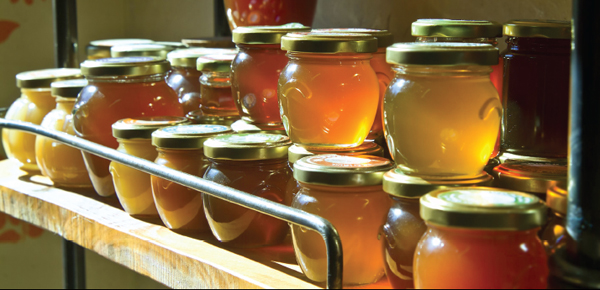
Precautions for Using Honey
Raw, unprocessed honey can cause allergic reactions due to the presence of small amounts of certain phytochemicals, pollen, or bee dander. Sometimes switching to another variety of honey or using processed honey solves the problem.
Children under ten to twelve months of age should not be fed raw or pasteurized honey unless under medical supervision. Although honey is relatively sterile, it may contain some hardy bacterial and fungal spores that can survive pasteurization. While the minor amount of spores in honey poses no risk for adults or even toddlers, infants may suffer serious infections, particularly botulism.
Botulism is caused by a virulent toxin produced by the bacterium Clostridium botulinum, which naturally exists in soils. The bacterial spores don’t germinate inside adult humans or children because our stomach acid kills them. However, because infants don’t produce strong stomach acid, the spores can germinate in their intestines. Honey used topically to treat minor wounds and infections doesn’t pose a botulism risk unless it can be licked off. (Note that it wouldn’t make sense to heat honey to very high temperatures to render it sterile for infant consumption, as this would destroy its healing properties.)

 oney is made from flower nectar collected by worker bees in spring, summer, and early autumn. Some worker bees also collect the sugary secretions of aphids that feed on tree sap, a substance known as honeydew. The gathered nectar is stored in wax cells, thousands of which form the honeycomb. It is concentrated as the bees fan the comb with their wings to drive off excess moisture. In a natural honeybee colony, honey serves as food for the bees through the winter, when plants are dormant. In an apiculture hive, most of the honeycomb is removed to harvest the honey and beeswax, and the beekeeper provides sugar or corn syrup solution to sustain the bees.
oney is made from flower nectar collected by worker bees in spring, summer, and early autumn. Some worker bees also collect the sugary secretions of aphids that feed on tree sap, a substance known as honeydew. The gathered nectar is stored in wax cells, thousands of which form the honeycomb. It is concentrated as the bees fan the comb with their wings to drive off excess moisture. In a natural honeybee colony, honey serves as food for the bees through the winter, when plants are dormant. In an apiculture hive, most of the honeycomb is removed to harvest the honey and beeswax, and the beekeeper provides sugar or corn syrup solution to sustain the bees.












